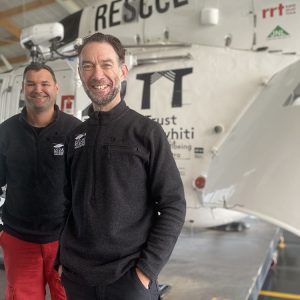The arrival of two new team members brings the Trust Tairāwhiti Eastland Rescue Helicopter team of critical care flight paramedics up to the optimum number needed to operate in the region.
And the news gets even better. The service on Friday learned it had approval to also increase its teams of pilots and crewman from three to four each.
“For a while we were operating with just two paramedics which meant that to maintain the 24/7 rescue service, we often had to bring in cover from out of town,” says base manager Richard Curtis, himself one of the team’s critical care flight paramedics.
“Now we avoid having any gaps in the roster, which makes for much smoother team management while also preventing paramedic fatigue.
“To be able to do that with our pilots and crewman, too, is fantastic in terms of the safety and functionality of our rescue service.”
Increasing the team numbers required sign-off from the National Ambulance Sector Office (NASO), which manages contracts across all emergency ambulance services.
The actual job of employing them is done by the Search and Rescue Services (SRSL) company that manages operations on behalf of its five helicopter trust owners, including Gisborne’s Eastland Helicopter Rescue Trust (EHRT).
EHRT chair Patrick Willock says he is gratified to see the team grow without more pressure on the trust’s fundraising obligations, which remain at an annual minimum of $300,000.
“But that is just the contractual amount we need to pay SRSL for its operations,” he says.
“On top of that we have to fund a multitude of other things from the purchase of critical medical equipment to our fuel supply on the East Coast. As our team gets larger, so does the cost of outfitting them with the specialist equipment they require to do their jobs, but that’s a price we’re willing to pay.”
The team’s growth is a big step up from just a few years ago when the rescue helicopter had just one on-call pilot and single on-call ambulance officer, says Mr Willock.
“To this day there are no critical care paramedics based around the coast from Gisborne to Whakatane, so there is probably no area of the country that needs a quality helicopter rescue service more than ours does,” he says.
“We need to ensure the care we put into our more remote communities is equal or better than anywhere in the country while avoiding any risks around safety or fatigue.
“Our new team members help us do that, so we couldn’t be more pleased to see them.”
For one of the two new paramedics, Gareth McDougall, joining the Tairāwhiti team marked a return to his hometown after more than 20 years away, most recently in Sydney where he worked for the New South Wales ambulance service.
English import Thomas Grantham came from even further afield on the latest leg of a career journey that had taken him from his home in the West Midlands to Saudi Arabia, Abu Dhabi, and both land- and air-based services across Australia.
Before officially coming on board, both spent two weeks at SRSL’s Taupo base to undergo medical induction, and to brush up the aviation skills needed for use in the Gisborne service’s BK-117 helicopter.
“We’re incredibly fortunate to have them,” Richard Curtis says. “They both have a massive amount of experience across different roles and locations, so they bring yet another dimension to the team.”
CAPTION: The Trust Tairāwhiti Eastland Rescue Helicopter team has been boosted with the arrival of permanent critical care flight paramedics Gareth McDougall (left) and Thomas Grantham.
